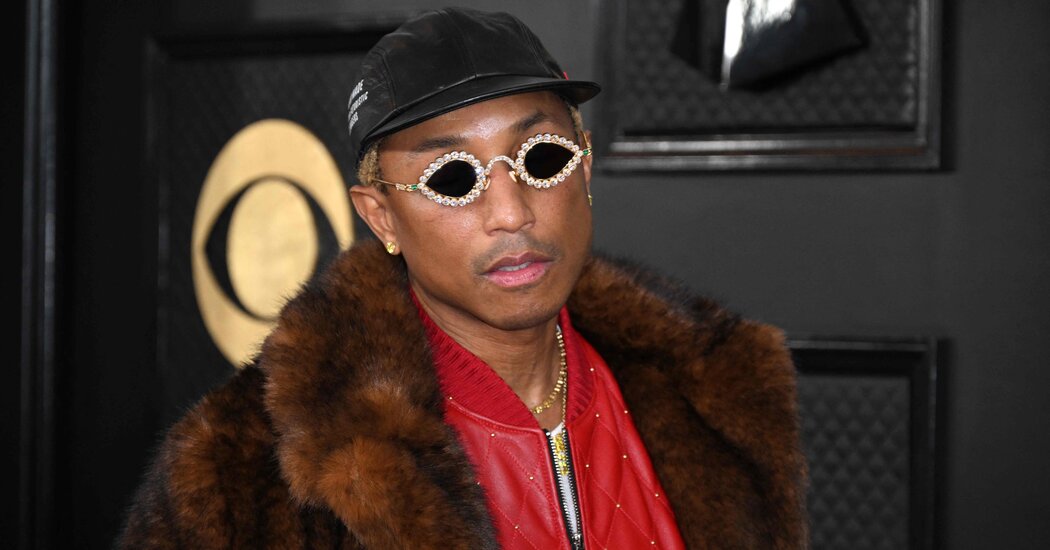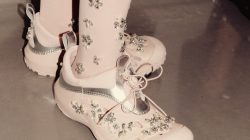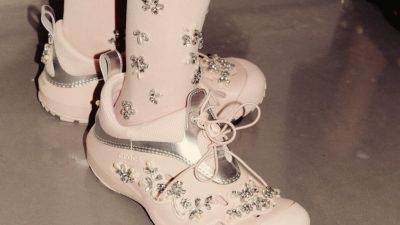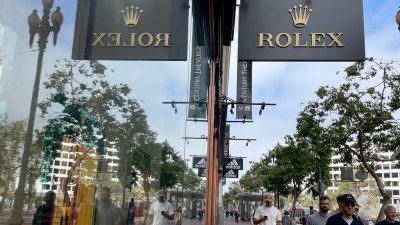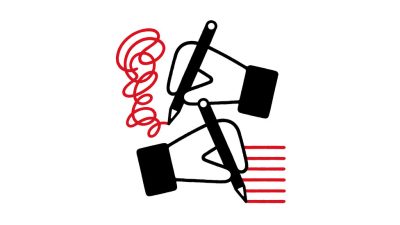Earlier this month at the Grammys, Pharrell Williams hit the red carpet in a striking look: an Ernest W. Baker quilted red leather tracksuit under a faux fur jacket, pointy black boots and diamond-rimmed teardrop-shaped glasses by Tiffany.
It was both rigid and a little sleazy, speedy and yet unhurried. More crucially, it felt like a deeply embedded and tastefully restrained nod to early hip-hop fashion, when louche 1970s sensuality was giving way to ’80s concrete realism. In hip-hop’s 50th anniversary, Mr. Williams, one of the defining music producers of the 2000s and one of the genre’s longstanding style innovators, was sending quietly coded messages about how he has inherited and absorbed the élan of those who came before him.
And with his appointment as the creative director for men’s wear at Louis Vuitton, announced last week, perhaps a quietly coded message about how he would both guide the company moving forward, and how Mr. Williams, the first hip-hop performer to lead a major fashion house, might assume the reins from Virgil Abloh, who held the job until his death in 2021, and whose framework has remained central to subsequent collections.
More than any hip-hop celebrity outside of Ye (formerly Kanye West), Mr. Williams has made carving out provocative fashion territory central to his métier. From art-skate brat to cartoon-bling hyperrealist to funhouse-mirror schoolboy to extravagant hippie, he has been experimenting with his personal canvas for more than two decades. And he has been a high fashion collaborator for almost as long, working with Louis Vuitton in addition to Chanel, Moncler and Tiffany.
Within hip-hop, Mr. Williams has been influential and also an idiosyncratic dandy whose sartorial experiments, especially in more recent years, fall far outside of conventional silhouettes. Frequently, on the red carpet, he’ll wear a slender suit with shorts that hit right above the knee — sometimes successfully, like his black tie look at the 2014 Oscars, and sometimes more awkwardly, like the camouflage get-up at the 2019 Oscars. At the 2014 Grammys, he wore a red leather track jacket with an oversize brown Vivienne Westwood derby, an outfit that launched 1,000 memes. It was a visual distortion from someone who ordinarily presents as tightly controlled, and a pop culture Rorschach test for tolerance of male quirk.
None of these outfits particularly scream hip-hop, which is one reason cynical reads of Mr. Williams’s appointment — as a simple and perhaps craven acknowledgment of hip-hop’s ongoing influence on contemporary men’s wear — are insufficient.
Instead, Mr. Williams has a distinctive approach to luxury, one that begins with hip-hop’s commitment to the reappropriation of class signifiers, but also extends to Californian leisure, Japanese whimsy, European sleekness and the unbothered calm of royalty. He consistently telegraphs opulence and panache, in a manner that feels learned but not studied.
Mr. Williams’s style is a demonstration of the ways in which hip-hop style can be expressed as ideology, a set of principles, even through clothes that come from different traditions.
In this, he is a philosophical split from Mr. Abloh, who took familiar hip-hop style references — debossed leather jackets, baggy jeans, basketball sneakers — and upstreamed them into the Louis Vuitton atelier. Mr. Abloh approached clothing design with childlike artistic vim, poking and tearing and drawing until a new version of an old thing began to feel as if it had always been that way. A tinkerer and a D.J, he took Louis Vuitton, always the least precious of the French houses, and made it radically current, imbibing the spirit of Dapper Dan and making wardrobe essentials for hip-hop’s new money elite (and the young people who imitate them).
Mr. Abloh has spawned imitators, both in literal design and also in approach. The codes of the last few years of men’s luxury have indisputably been hip-hop derived, even when the designer didn’t emerge from the hip-hop community. But no designer or house has quite replicated the Abloh blend of colorful imagination and joyous provocation.
Mr. Williams seems unlikely to try, either, though he has occasionally shown a similar penchant for remixing and amplifying hip-hop staples. For Moncler in 2010, he designed a glossy black down vest cut in the shape of a bulletproof vest, made of yarn derived from recycled plastic bottles. And nowhere is this impulse more clear than in the series of jewelry pieces he designed alongside Jacob Arabo, the longtime hip-hop jewelry icon.
At Mr. Williams’s recent auction of his jewelry on Joopiter, his own auction platform, he sold several of these pieces, including a diamond-covered Rubik’s Cube key chain; yellow gold skateboard pendants covered in white pink and yellow diamonds; a gold grill embellished with diamonds, emeralds, sapphires and rubies; and the pièce de résistance, the 2005 N.E.R.D. chain with pastel diamond-covered links and the three members of the group rendered as sparkling cartoon characters.
But these pieces date to the early years of Mr. Williams’s career, not long after he founded Billionaire Boys Club with Nigo, which specialized in cheerful allover print hoodies and sneakers and which were a streamlined, Japanese-influenced version of what was happening elsewhere in hip-hop style.
More recently, Mr. Williams has become preoccupied with old-money luxury and ways to subvert it from within. His 2019 collaboration with Chanel included cheeky color-blocked mules and loafers, an oversize flap bag, circular sunglasses and a tufted oversize tote bag in berry and citrus colors — all of which had his name emblazoned in a manner so natural it barely registered as the disruption it was. (The full contours of Mr. Williams’s relationship with Tiffany, another LVMH brand, aren’t known. But for more than a year, he has been wearing those diamond glasses.)
Not all of his clothing collaborations have been aesthetic successes. His sneaker projects with Adidas have generally underwhelmed — some Stan Smiths in surprising colors and his socklike NMD Humanrace running sneakers, with laces across only the top of the foot, were modern but clunky. (The athletic clothing from Williams’s brand Humanrace is inessential, but apparently the skin care products are solid.)
But those have always felt like the most pro forma part of his fashion catalog, the shrugging work of a famous person granted low-hanging money.
Mr. Williams’s new job demands more, of course. Now an employee of LVMH, the actual billionaire boys club, he will have the luxury of relying on others to fully build his vision — not simply the designers and patternmakers in the Vuitton atelier, who, like the permanent staff of the White House, serve regardless of who’s in charge.
Perhaps he’ll tap talent like Cynthia Lu, his onetime assistant and stylist, whose brand Cactus Plant Flea Market is a clever and earthen take on streetwear (and has lately collaborated with Nike and McDonald’s). Or almost certainly Nigo, the founder of A Bathing Ape and an inspiration for several generations of streetwear designers, who Mr. Abloh brought on as a collaborator and who has been in league with Mr. Williams for two decades.
Both of those designers have made careers predicated on an expansive and forward-looking read on how hip-hop and streetwear culture could be refined, embellished and expanded.
Given the vast resources of LVMH, it’s likely Mr. Williams will want to do the same. In choosing him to direct its men’s wear, Louis Vuitton gets to have it both ways — continue the optics-level embrace of hip-hop, its culture, its audience and its spending power, while also moving past the familiar touch points of hip-hop style.
His appointment also sets the table for younger hip-hop stars with signature style — Tyler, the Creator, or maybe ASAP Rocky — to perhaps someday take on a similar role. Wearing clothes well is, of course, not the same thing as designing them. But the role of a contemporary creative director is something more akin to zeitgeist interpreter. Mr. Williams has been living in hip-hop, and looking into the future, for more than 20 years, a valuable perspective for a luxury men’s wear world that has already absorbed hip-hop and is hoping to divine what might come next.
Sumber: www.nytimes.com
